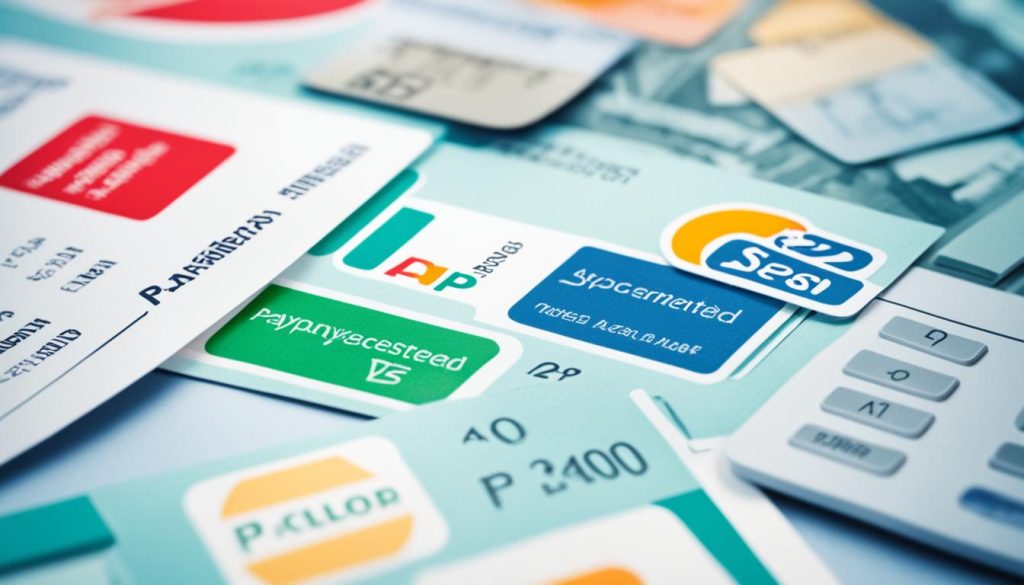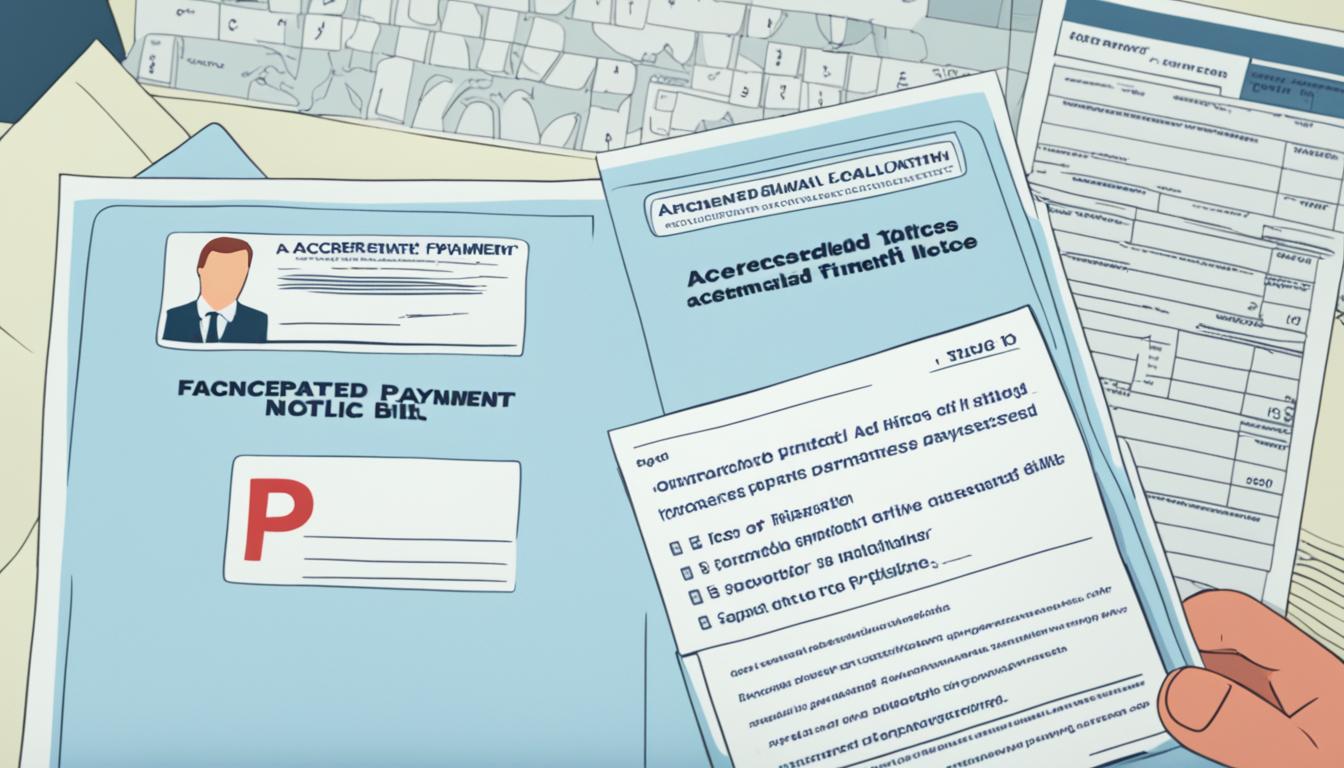Welcome to our comprehensive guide on accelerated payment notices (APNs) in the United Kingdom. In this article, we will delve into the details of APNs, their significance in tax law, how they are issued by HM Revenue and Customs (HMRC), and their role in addressing tax avoidance schemes. Understanding and complying with APNs is crucial to ensure compliance with tax legislation and avoid potential penalties.
What is an Accelerated Payments Notice (APN)?
An accelerated payment notice (APN) is a requirement to pay an amount on account of tax or National Insurance Contributions (NICs). It is issued by HMRC to taxpayers involved in avoidance schemes disclosed under the Disclosure of Tax Avoidance Schemes (DOTAS) rules or counteracted under the General Anti Abuse Rule (GAAR). APNs can also be issued to taxpayers who have received a Follower Notice in relation to the scheme.
The purpose of APNs is to ensure that disputed tax or NICs are paid upfront, removing the cash flow advantage enjoyed by users of tax avoidance schemes. Taxpayers receiving an APN have 90 days to pay the amount due, and they have the right to appeal if they believe the amount is incorrect or the conditions have not been met.
Key Features of an APN:
- Issued by HMRC to taxpayers involved in disclosed tax avoidance schemes
- Applies to both tax and National Insurance Contributions (NICs)
- Used to remove the cash flow advantage enjoyed by tax avoidance scheme users
- Requires payment within 90 days of receiving the notice
- Allows taxpayers to appeal if they disagree with the amount or conditions

5 Things You Need to Know if You Have Received an Accelerated Payments Notice
If you have received an accelerated payment notice (APN), it is crucial to be aware of the following five important factors:
- Prompt Payment: It is essential to pay the amount due within 90 days of the notice being issued. Failure to comply with the payment deadline can lead to penalties for late payment and enforcement action by HMRC.
- Take Immediate Action: Ignoring the APN is not an option. It is crucial to take prompt action and address the notice as soon as possible.
- Possible Multiple APNs: If you have been involved in multiple tax avoidance schemes, it is possible to receive more than one APN. Each notice will require separate payment.
- Partial Coverage: Paying the APN balance will only cover the tax advantage gained from the specific scheme mentioned in the notice. Any other tax liabilities must be paid separately.
- Appeal Rights: As a recipient of an APN, you have the right to appeal if you believe the amount specified in the notice is incorrect or if the conditions for the APN have not been met.
It is essential to understand these key aspects of an APN and fulfill your obligations accordingly. Adhering to the payment deadline, taking immediate action, recognizing the possibility of multiple APNs, understanding the partial coverage, and exercising your appeal rights are crucial for managing the impact of an APN effectively.

What Can Be Done if I Receive an APN?
If you find yourself facing an accelerated payment notice (APN), it’s important to know that there are steps you can take to manage the situation effectively. When dealing with an APN, seeking advice from an insolvency practitioner can prove beneficial. These professionals can assist in liaising with HM Revenue and Customs (HMRC) on your behalf, ensuring effective communication and negotiation.
An insolvency practitioner can also provide guidance on restructuring and refinancing options that may help you meet the payment demand. They have the experience and expertise to assess your financial situation and explore alternative solutions to resolve your tax obligations.
Engaging with HMRC early on is crucial when dealing with an APN. By proactively communicating with them, you can demonstrate your willingness to cooperate and find a resolution. Working with an experienced adviser can help you navigate the process and ensure compliance with tax legislation.
Considering the potential consequences of not taking action, seeking professional help becomes even more important. Ignoring an APN can result in penalties and enforcement action being taken by HMRC. By seeking advice from an insolvency practitioner, you can address the situation proactively and find the best possible outcome.

Benefits of Seeking Help from an Insolvency Practitioner:
- Expertise in dealing with HMRC: Insolvency practitioners have extensive experience in handling tax-related matters and can effectively communicate with HMRC on your behalf.
- Restructuring options: They can assess your financial situation and provide guidance on restructuring options that can help you meet the payment demand.
- Refinancing advice: Insolvency practitioners can explore refinancing options that may provide the necessary funds to satisfy your tax obligations.
- Professional representation: Having an experienced adviser by your side can give you confidence during discussions and negotiations with HMRC.
- Compliance and peace of mind: Working with an insolvency practitioner ensures that you are following the appropriate processes and taking the necessary steps to address your tax liabilities.
Dealing with an APN can be complex and overwhelming. Seeking help from an insolvency practitioner can alleviate some of the stress and uncertainty associated with the process. It’s important to remember that every case is unique, and professional advice tailored to your specific circumstances can make a significant difference.
What to do if you’ve been involved in a tax avoidance scheme and receive a follower notice or accelerated payment notice from HMRC?
If you have been involved in a tax avoidance scheme, it is important to understand the actions you need to take if you receive a follower notice or accelerated payment notice (APN) from HM Revenue and Customs (HMRC). These notices are issued in different circumstances and require specific steps to be followed.
Follower Notice
A follower notice is issued when you have used a tax avoidance scheme that is similar to one that HMRC has successfully challenged. The purpose of this notice is to prompt you to settle your tax affairs with HMRC to avoid potentially severe penalties. It is crucial to take this notice seriously and address your tax liabilities promptly to mitigate the consequences.
Accelerated Payment Notice (APN)
An accelerated payment notice (APN) is issued if there is an ongoing enquiry, dispute, or appeal related to your tax affairs and you have either received a follower notice or are involved in a disclosed tax avoidance scheme. This notice requires you to pay the disputed tax amount within a specified period, typically 90 days from the date of the notice.
Complying with the APN is essential to ensure timely resolution of the tax matter and avoid additional penalties. If you fail to pay the required amount within the given timeframe, HMRC can take enforcement action, resulting in further consequences.
To effectively handle the situation:
- Review the notice carefully: Read the notice thoroughly to understand the specific requirements and deadlines.
- Assess your tax position: Evaluate your tax position and liabilities, considering the scheme involved and the amount of tax in dispute.
- Contact HMRC: If you have any questions or concerns regarding the notice, contact HMRC using the provided contact details to seek clarification.
- Seek professional advice: Consider consulting a tax advisor or accountant with expertise in dealing with avoidance schemes and HMRC interactions.
- Take appropriate action: Based on the advice received, take the necessary steps to comply with the notice and resolve the tax matter in accordance with HMRC guidelines.
It is important to note that failure to follow the instructions in the notices may lead to penalties and further legal consequences. Ignoring the notices or delaying action can result in significant financial penalties, as HMRC has various enforcement powers to recover the tax owed.
Contact HMRC
If you require assistance or have any questions regarding the notices you have received, it is advisable to contact HMRC directly. They can provide guidance and clarification on your specific situation and help ensure compliance with tax regulations.
Remember, addressing the follower notice or APN promptly and in accordance with HMRC’s requirements can help resolve the tax matter efficiently and protect your rights as a taxpayer.
| Key Points: |
|---|
| If involved in a tax avoidance scheme, you may receive a follower notice or APN from HMRC |
| Follower notice prompts settlement of tax affairs to avoid penalties |
| APN requires payment of disputed tax within a specified period |
| Review notices, assess tax position, and seek professional advice |
| Contact HMRC for clarification and guidance |

Penalties and Appeals
Failure to comply with the steps outlined in a follower notice or accelerated payment notice may result in penalties. If you do not take action as instructed in the notice, HMRC may issue a notice of penalty assessment specifying the amount and deadline for payment. It is crucial to understand the implications and consequences of non-compliance, as penalties can have a significant impact on your finances and reputation.
Penalties for non-compliance with follower notices or accelerated payment notices can vary depending on the specific circumstances and the amount of tax involved. HMRC has the authority to impose penalties based on a percentage of the tax liability, which can range from 15% to 100%.
Appealing against any penalties received from HMRC is an option available to taxpayers. However, it is important to note that a formal appeal cannot be lodged against the notice itself, but against the penalty assessment. If you believe that the penalty amount is incorrect or that the conditions for the penalty are not met, you can follow the instructions provided in the penalty assessment notice to initiate the appeals process.
Follower Notice Appeals
When appealing against a penalty related to a follower notice, you will need to demonstrate that your case is materially different from the situation that has already been decided by HMRC or the tax tribunal. It is essential to provide evidence and arguments that support your position and highlight the distinctions between your circumstances and the previously decided case.
Accelerated Payment Notice (APN) Appeals
For appeals related to an accelerated payment notice (APN), the process may vary depending on the specific grounds for appeal. You may appeal against the penalty if you believe that the amount specified in the notice of penalty assessment is incorrect, or if you can prove that the conditions for the penalty have not been met.
It is important to note that while the appeals process is available, it is advisable to seek professional advice, such as consulting a tax advisor or engaging a tax lawyer, to navigate the complexity of the appeals process and ensure the best possible outcome for your case.
| Step | Description |
|---|---|
| 1 | Receive notice of penalty assessment from HMRC specifying the amount and deadline for payment |
| 2 | Assess the penalty amount and conditions for compliance |
| 3 | If you disagree with the penalty assessment, follow the instructions provided in the notice to initiate the appeals process |
| 4 | For appeals related to follower notices, demonstrate that your case is materially different from the previously decided case |
| 5 | For appeals related to accelerated payment notices (APNs), provide evidence and arguments to prove the incorrectness of the penalty amount or non-compliance with the penalty conditions |
| 6 | Consider seeking professional advice from a tax advisor or tax lawyer to assist with the appeals process |
Conclusion
Dealing with an accelerated payment notice can be a challenging process. Taxpayers must understand the implications and take the necessary steps to comply with the notice. Tax avoidance schemes can have serious tax consequences, and it is important for individuals to be aware of their rights. If taxpayers believe that the notice is incorrect or the conditions have not been met, they have the right to appeal.
Engaging with HMRC early on and seeking professional advice can be beneficial in navigating the complexities of an accelerated payment notice. By doing so, individuals can ensure compliance with tax legislation and avoid further complications. It is crucial to understand the potential consequences and act promptly to address the situation.
In cases where a tax investigation is initiated, taxpayers must cooperate and provide the necessary information to HMRC. Failure to do so can lead to additional penalties and legal consequences. It is therefore advisable to approach an accelerated payment notice with diligence and seek expert guidance to protect taxpayer rights and mitigate potential risks.
FAQs
What is an Accelerated Payments Notice (APN)?
An accelerated payment notice (APN) is a requirement to pay an amount on account of tax or National Insurance Contributions (NICs). It is issued by HM Revenue and Customs (HMRC) to taxpayers involved in avoidance schemes disclosed under the Disclosure of Tax Avoidance Schemes (DOTAS) rules or counteracted under the General Anti Abuse Rule (GAAR).
What are 5 things you need to know if you have received an APN?
– You must pay the amount due within 90 days of the notice being issued.
– Ignoring the notice is not advisable, prompt action should be taken.
– It is possible to receive more than one APN if you have been involved in multiple schemes.
– Paying the APN balance will only cover the tax advantage gained from the scheme, and any other tax liabilities must still be paid separately.
– You have the right to appeal against the APN if you believe the amount is incorrect or the conditions have not been met.
What can be done if I receive an APN?
If you receive an APN, you can seek advice from an insolvency practitioner who can assist in liaising with HMRC on your behalf and provide guidance on restructuring and refinancing options to meet the payment demand. It is important to engage with HMRC early on and work with an experienced adviser to navigate the process effectively.
What to do if you’ve been involved in a tax avoidance scheme and receive a follower notice or accelerated payment notice from HMRC?
If you have been involved in a tax avoidance scheme, you may receive a follower notice, accelerated payment notice (APN), or both from HMRC. A follower notice is issued when you use a scheme similar to one that HMRC has successfully challenged. It asks you to settle your tax affairs with HMRC to avoid penalties. An APN is issued when there’s an ongoing enquiry, dispute, or appeal related to your tax affairs and you have received a follower notice or are involved in a disclosed tax avoidance scheme. It requires the payment of disputed tax within a specified period. It is crucial to follow the steps outlined in the notice received and to contact HMRC if needed.
What are the penalties and how can I appeal against them?
Failure to comply with the steps outlined in a follower notice or accelerated payment notice may result in penalties. If you do not take action as instructed in the notice, HMRC may issue a notice of penalty assessment specifying the amount and deadline for payment. It is possible to appeal against any penalties received from HMRC regarding follower notices or APNs. Although a formal appeal cannot be lodged against the notice itself, instructions on what to do if you disagree with it are provided.
What are the consequences of an accelerated payment notice and are there any rights for taxpayers?
Dealing with an accelerated payment notice can be a challenging process. It is important to understand the implications and take the necessary steps to comply with the notice. Tax avoidance schemes can have serious tax consequences, and taxpayers have rights to appeal if they believe the notice is incorrect or the conditions have not been met. Seeking professional advice and engaging with HMRC early on can help navigate the complexities of an accelerated payment notice and ensure compliance with tax legislation.





